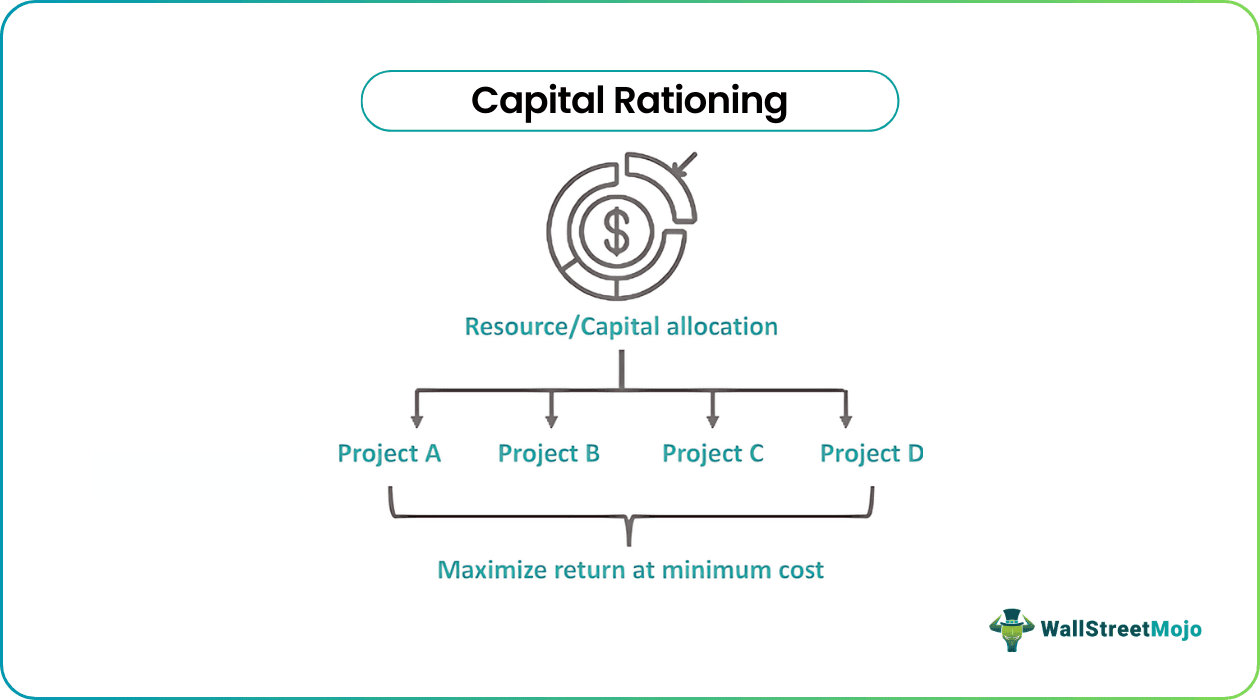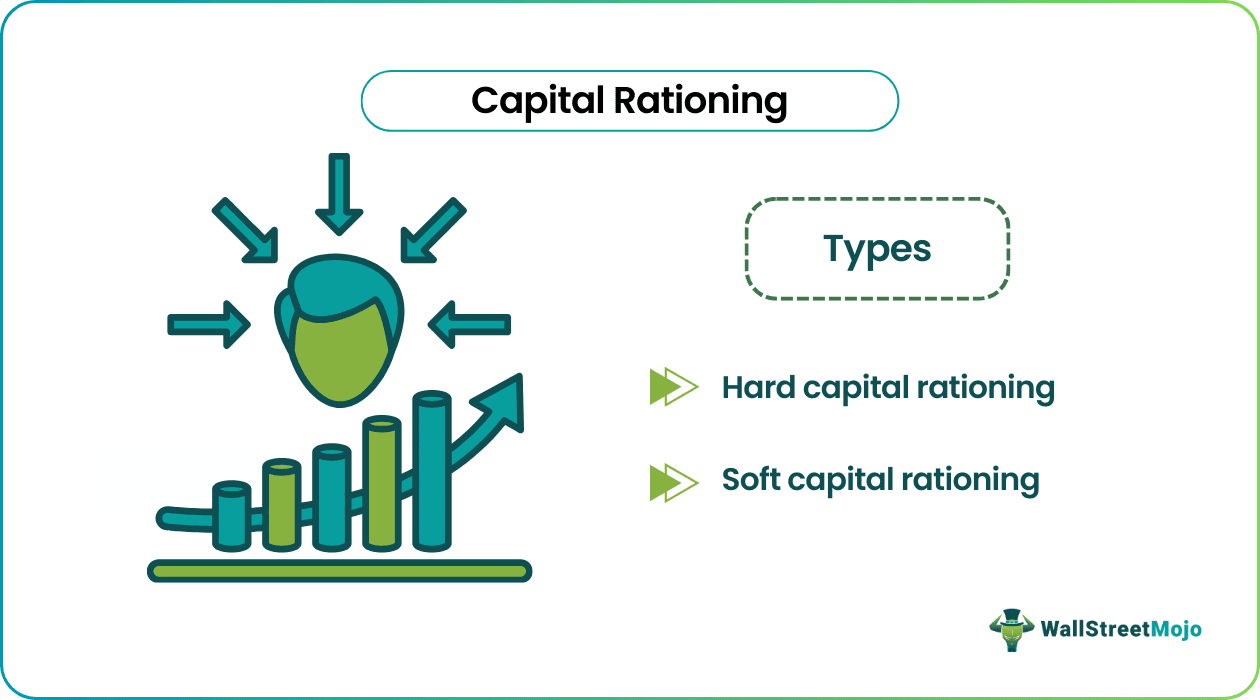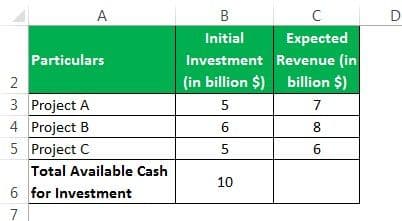Table Of Contents
What Is Capital Rationing?
Capital rationing is a process or a method applied to select and allocate a combination of project mix in a manner made of shareholder's wealth with limited initial investment amount available for investing in several projects under consideration.

Capital rationing is a process of selecting a project mix that will provide the maximum profit by investing the limited capital available in various projects. The process is followed after considering the restrictions in place, whether internal or external forces, for the investments to be made.
Key Takeaways
- Capital rationing is a procedure or strategy used to choose and distribute a combination of shareholders’ wealth using initial investment.
- Soft rationing is when the practice of limiting the usage of capital funds for diverse projects by constraints set by management.
- Capital rationing is caused due any limitations imposed by the management or not having enough people or knowledge to complete all the projects.
- The idea of capital rationing is predicated on the idea that the project will produce a specific return. Any error in estimating the same would lead to lower profits from the project.
Capital Rationing Explained
Capital rationing in capital budgeting is a process followed by companies in which the finance is managed through efficient capital or resource allocation in different investments or projects. The management needs to assess the right amount of fund needed in different areas so that maximum positive returns are generated with minimum investment and cost.
With innumerable opportunities available in the market that can contribute to growth and expansion, it is important to prioritize capital allocation in each of them so that the objectives and strategies planned by the management is obtained by staying within the risk tolerance level and any financial constraint is handled well.
In the process, the business needs to evaluate various investment opportunities by implementing different financial metrics that are commonly used for assessment, like Internal Rate of Return (IRR), Net Present Value (NPV), and other widely used measures. Based on the results of these measures, the projects should be ranked and the management can select the ones that fit best as per the objectives, financial limitations and budgets and the risk profile of the business.
The process of capital rationing in capital budgeting can definitely help in rationing or allocation of capital in an optimum manner but this may also result in loss of potential valuable investment options if the evaluation is not done properly.
Types
Capital rationing decisions can be segregated based on two types. The first is known as hard rationing, and others are referred to as soft rationing.

- Hard Capital Rationing means when the additional capital infusion or any restriction on the use of existing investment funding is limited by forces of external sources.
- Soft Capital Rationing refers to restrictions on the use of capital funding for various projects based on restrictions imposed by management and its capital rationing decisions.
Example
Let us take an example to understand the concept better.
Suppose there is a company named Yuva Constructions Ltd ('YCL'). YCL is engaged in the business of construction of buildings for residential and commercial purposes. It has secured the required preliminary permissions and approvals from the state government for constructing three projects – Project A, B, and C.
YCL has a total budget of $10 billion. Project A, B, and C are expected to yield total value (present value of cash flows) of $7 billion, $8 billion, and $6 billion respectively viz a viz the initial investment required for each is $5 billion, $6 billion and $5 billion respectively. Apply the capital rationing and find the optimal combination.
Solution:
First, let’s tabulate the information provided to us for ease of reference.

- Now, YCL has $10 billion. To maximize the investors' wealth, it will have to accept projects to receive the highest amount of profits within the limited budget of $10 million. Accordingly, it will have to find out the expected rate of return for all the projects and then rank them according to profitability index.
The below table thoroughly explains the same.

- Based on the ranks, YCL must select Project A and B, as they have the highest profitability. However, the total initial investment required if it chooses Project A and B would exceed the available funding, i.e., it will require $11 billion ($5 billion + $6 billion) compared to the available $10 billion.
- In such a situation, it will have to discard one project and move to the next ranking project which suits its investment needs. Thus, YCL will have the option to go ahead with Project A and C, which will entail an investment well within the available capital of $10 billion and will have to forego investing in Project B.
Assumptions
Some of the assumptions are as follows.
- The primary assumption of multi period capital rationing is that there is a restriction imposed, either through internal forces or external, on capital funding.
- The other assumption followed here is that there are several projects to be undertaken by the company or investors. Selecting certain projects will help optimize returns for the investment made.
- Lastly, the concept of capital rationing is based on the assumption that the expected rate of return of proposed projects to be undertaken shall be achieved as expected, thus ignoring practical factors such as economics, politics, policies, and such.
- It also assumes that the investment options are mutually exclusive, which means that the funds invested cannot be used for accessing any other project simultaneously.
- It also considers the projects evaluated as having the higher ranking as per different evaluation metrics to be the best options. In other words, the main factor of assessment is the metric.
- It considers the projects to be independent and not linked to each other in any manner. The cash flows and the resultant profitability makes the process of decision making very easy and simple, since any dependency or mutual interaction among the investments are rules out.
- The concept of multi period capital rationing assumes a fixed time period for evaluation. This time period is based on market performance, objectives of the business and other external and internal factors related to the business.
- The capital market is assumed to be perfect in the sense that there is no asymmetry in flow of information, and there is not transaction cost or taxes charged, which is not actually a real world situation.
- The process considers the risk and fixes the discount rate based on the level of risk. However, there may be differences or variations in risk tolerance levels and a lack of accuracy in projecting the value of the investment. This will affect the investment selection process.
It is important to understand that all assumptions may not hold true in the real world because companies face a lot of challenges and complexities while taking capital allocation decisions.
Reasons
Efficient resource allocation is essential for any company for various reasons, as mentioned below.
- The increased cost of capital for higher capital/funding requirements.
- Higher debt in books of the company.
- Any internal management restriction.
- Lack of human resources or knowledge for undertaking all the projects.
- Company’s focus on long term growth, expansion and profitability.
- Manage the risk exposure and avoid any kind of over or under investment in any projects that may not yield satisfactory return.
- In case the projects are interdependent or linked to each other in any way, then capital rationing will help in avoiding putting too much funds in one at the cost of the other, thus ensuring proper division of resource.
- It solves the problem of resource constraint. Shortage of skilled labor, raw materials or technical knowhow will force businesses to frame policies and rules to implement the resource in such a way so that there is maximum use and minimum wastage.
Advantages
The use of the concept of capital rationing does come with its shares of advantages and benefits for the users. Some of the benefits are as follows.
- Any restriction on the use of available resources, in our case money, will utilize the resource in the best optimal manner.
- The company's management or investors would not invest in any project coming their way without getting into detailed analysis. This ensures there is no wastage or unnecessary use of free funds available.
- The investors would receive the highest or maximum returns on their investments by following the optimal utilization process.
- It may entail investing in only a few projects, which would help the management put in lesser efforts in managing the affairs of the projects and yield better results.
- The company or the investor will have funds available even after investing in the projects, thus ensuring there is no cash crunch.
Disadvantages
Some of the limitations of the concept of capital rationing are as follows.
- It focuses on investing in fewer projects, which keeps the balance shareholder funds idle.
- The concept of capital rationing is based on the assumption that the project will yield a particular return. Any miscalculation of the same would result in the project generating lesser profits.
- Projects that are selected may be of smaller duration, which would lead to discarding certain long-term projects, which may be healthy for the company's stability.
- The evaluation process ignores any intermediate cash flows that the project may have and the time value associated with such cash flows.
Capital Rationing Vs Unlimited Funds
| Capital Rationing | Unlimited Funds |
|---|---|
| A situation with fixed capital in hand and to choose the projects based on profitability. | A situation with no cap on capital/funding available and thus undertake any project with suitable profitability. |
| You select the project based on ranking arrived by considering the rate of return and fixed capital investment. | You either accept or reject the project based on the required acceptance criterion. |
| The focus is on maximizing shareholder wealth. | The focus is on generating at least minimum acceptable returns. |
| There may be funds idle post applying capital rationing. | Investors utilized all the money and make investments. |

